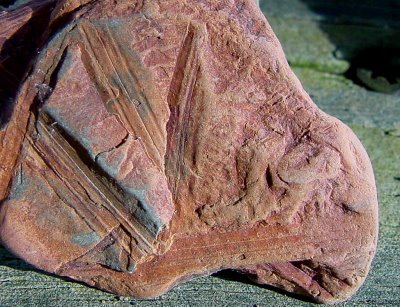On page 14 of volume 2 of the The Berlin Family by Reginald Berlin, published in 1992, the author writes:
Jacob Berlin is buried at Abbottstown, Pennsylvania in the Lutheran Cemetery, in the old section, across the street from St. John's Lutheran Church. On his tombstone, which is still readable, is the following inscription: "Here rests the body of Jacob Berlin. Born the 6th of December 1716, Died the 7th of April 1790. Aged 73 years 3 months, 3 weeks. Now has my struggle in life ended. My work in life is finished. I go forth to my Jesus and say to all a good night."
The transcription of Jacob's baptismal record (from the Zahn Collection, Historical Society of York County) shows that Johann Jacob was born to Johann Georg Berlin and Anna Elisabetha on the 17th of December of 1716 and baptized on the 19th. Godparents were Mister Johann Jacob Arbogast; Anna Barbara, Mr. Johann Philips Pfaltzgraff citizen here and married housewife; Mister John Martin Gross, citizen and a miller at the lower mill.
According to the baptismal record Jacob was born on December 17th while his tombstone states that he was born on December 6th. But the two dates actually refer to the same day.
In 1582, there was an adjustment to the calendar year known as the "Gregorian reform" in which ten days were omitted from the calendar. It was decreed that the day following (Thursday) October 4, 1582 would be known as (Friday) October 15, 1582. However, by the time the British were ready to go along with the rest of Europe, the old calendar had drifted off by one more day, requiring a correction of eleven days, rather than ten. The Gregorian Calendar was adopted in Britain (and in the British colonies) in 1752, with (Wednesday) September 2, 1752, being followed immediately by (Thursday) September 14, 1752. Do a search for "Julian Calendar" or "Gregorian Calendar" and you'll find tons of info out there and some explanations that strain the mind.
Anyway, after writing yesterday's post There were three brothers who immigrated... Yeah, Right! I went out on the Internet to see if there was a photo of Jacob's tombstone available.
A quick search of Find A Grave for Jacob Berlin, died 1790, came up empty. I scrolled through the list of cemeteries for Adams County Pennsylvania looking for any Lutheran Church cemetery in Abbotstown and found it listed as Saint John's Lutheran Cemetery. He is listed there as Jacob Berlien, which is the name on his tombstone. Imagine that!
The photo on Find A Grave wasn't the best so I did a search for "saint john's lutheran church cemetery abbottstown pa" the second result in the list said there were tombstone photos of "St. John's Lutheran Church Cemetery, Abbottstown, Adams County, PA." Ya gotta watch those "saints" since sometimes they are abbreviated and other times they're not!
I was in luck because there was a rather nice photo of Jacob's tombstone. I contacted the submitters of the photo (Margaret Gagliardi and Ken Schultz) and obtained their permission to use the photo. Thank you very much Margaret and Ken!

Photo courtesy of Margaret Gagliardi and Ken Schultz and the Adams County, Pennsylvania US GenWeb Archives, used with permission. Tombstone of Jacob Berlien in St. John's Lutheran Church Cemetery, Abbottstown, Adams County, Pennsylvania.
I played around a bit with the photo in Picasa and came up with the version below.

The lowest part of the inscription is still not readable, but the rest of the stone is a little more legible. Using one of the online translation websites I came up with a literal translation of the words, shown below in square brackets.
Hier Ruher der Leib
[Hier = Here; ruhe = reposes or rests; der = of; Leib = body]
JACOB BERLIEN
Gebohrenden 6 December
[geboren = born; den = the]
1716
Gestorben den 7 April
[gestorben = departed, gone, dead; den = the]
1790
Alt 73 Jahr 3 Monat 3 Woch
[Alt = Alter = Age; Jahr = Years; Monat = Months; Woch = Woche = Weeks]
The inscription as shown in volume 2 of "The Berlin Family"Here rests the body of
Jacob Berlin
Born the 6th of December 1716
Died the 7th of April 1790
Aged 73 years 3 months 3 weeks
Now has my struggle in life ended.
My work in life is finished.
I go forth to my Jesus and say to all a good night.
The translation of the inscription from Find A Grave Memorial# 41797876Here lies the beloved
Jacob Berlien
born the 6th of December
1716
died the 7th of April
1790
Age 73 years 6 months and 3 weeks
Now that my struggle has ended
My journey is complete
I go to my Jesus
and say to all a good night
Regarding his age at death... Using the calendar in Legacy and inputting the dates 06 Dec 1716 and 07 Apr 1790 his age calculates to 73 years 4 months 1 day. Inputting 17 Dec 1716 as his date of birth, his age then comes out to 73 years 3 months 3 weeks.









